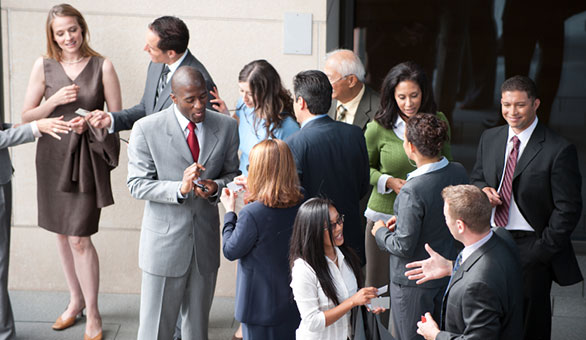
In Part 1 of our “Get Out and Network” series, we shared some online tools to help you identify networking events. So now that you’ve put some events on your calendar (we hope), in Part 2 we discuss how to network with flair and initiate business relationships that will last well beyond the first introduction and handshake.
BEFORE THE NETWORKING EVENT
Find Out Who’s Going
In the olden days, getting a hold of the event’s attendee list ahead of time was impossible. Today, thanks to the Internet, it’s easy to find out who plans to attend. You also can learn a person’s job title, current and past employers, how long they’ve been in the industry and their alma mater. Krista Canfield, LinkedIn’s Senior Manager of Corporate Communications and PR, encourages attendees to find out if the event sponsor or host has created a LinkedIn Event. If so you’ll be able to review the LinkedIn profiles of those planning to attend. Best of all, if an attendee’s LinkedIn profile has a photo, you’ll easily recognize them when they enter the room. Other event sites such as Eventbrite also list registered attendees.
Shift Your Focus
“All things being equal, people will do business with, and refer business to, those people they know, like and trust,' says Bob Burg, author of several best-selling books including The Go-Giver and Endless Referrals. Therefore, Burg teaches business professionals to “focus on the other person; not on yourself. Move from an 'I-focus' to an 'Other-focus' orientation. Don't go [to an event] looking for a 'quick hit' but rather attend to establish new relationships.” Interestingly, Burg believes that “introverts have a natural advantage for networking in that an introvert is often happier to ask good, Feel-Good, rapport-building questions and then let the other person talk about themselves. This is much more powerful in terms of establishing a relationship than simply blabbing about oneself and their product or service.”
Know More Before You Go
Sam Richter, internationally recognized sales intelligence expert and author of Take the Cold Out of Cold Calling, takes this further, turning something everyone knows – Knowledge is Power! –into reality. “When you Know More! about the people you are going to encounter, you ensure relevancy with every meeting, every time. With relevancy, you connect on a personal level, make the other person feel important, and achieve “permission” to ask meaningful, value-based questions.”
Richter’s Know More! methodology helps you discover much more than a person’s business profile and professional accomplishments. The “Invisible Web,” as Richter refers to sites on the web that search engines like Google don't index (e.g. sites that require registration to receive information), is all you need to reveal personal information such as an individual’s sports team preferences, political contributions, association affiliations and even golf handicaps. It’s this type of information, woven casually into conversations, that creates instant meaningful connections. So before you go, do a little research on others who will be attending.
DURING THE NETWORKING EVENT
Pay Attention to Your Face and Body
When people think of networking, verbal introductions and conversations come to mind. However, nonverbal behaviors—the gestures we make, how fast or how loud we talk, how much eye contact we make—send strong messages (positive and negative) to those standing in front of us as well as to those unknowingly observing us from across the room. Joyce Layman-Blackburn, refers to herself as a Motivational Mindset Speaker and points out how posture and facial expressions communicate more than you think. “If you think it's going to be ‘another one of those time-wasting events’ you'll convey that in your body language and tone of voice without realizing it.” People want to engage with “happy-to-be-here” people.
Show a Genuine Interest in Others
Focusing on others, instead of blabbing about yourself (or your company) is key. Burg suggests asking rapport-building questions that invite the other person to talk about themselves. And don’t feel the need to focus on business only. Questions related to family and hobbies make others feel important and are more effective in establishing meaningful relationships.
As for posing business related questions, Burg notes the incredible power of something he refers to as the “One Key Question,” which sounds like this. “Mary, how can I know if someone I'm speaking with would be a good prospect for you?' This “other-focused” inquiry conveys genuine interest in contributing to Mary’s future success, while providing you with insights about Mary’s business.
Think ‘Quality vs. Quantity’
If you think, that collecting the most business cards is the name of the game, think again. Instead, spend your time and energy making a handful of quality connections. Since many of us intuitively believe the more the merrier, Layman-Blackburn offers this perspective. “Everyone you meet has an average of 200 people in their circle-of-influence.” And Burg adds, “It isn't simply a matter of whether the person you meet might be a good prospect. In fact, it’s better to connect to someone who is a 'center of influence'... one who is known, liked and trusted by many.”
Ditch Your Sales Spiel at the Door
If you’re in sales, well, it’s hard not to sell. But the most successful sales people know relationships lead to referrals which lead to future sales. One way to cultivate authentic relationships is to “focus on providing value to others, rather than focusing on what you can get from them,” says Burg and this “creates a benevolent context for success.' And Layman-Blackburn agrees. “If you only focus on 'selling' to other people, you're missing out on HUGE opportunities that result from building true relationships!”
Record and Remember
What’s the best way to remember the interesting dialogues and facts you discovered about a new acquaintance? After you leave a conversation, take a few moments to jot down 2-3 interesting facts you learned as well as any commitments you made (e.g. to send an interesting article or to make a personal introduction to another colleague). When you get home, write the event name and date on each business card to make it easier to recall 3 or 6 months later.
AFTER THE NETWORKING EVENT
Personalize Your Follow Up
While it’s tempting to pick up the phone the next day and deliver your sales pitch to your new contacts, practice the “other focus” approach in your follow up. Burg suggests these ideas to help cultivate a relationship rather than land a sale.
-
Send a personalized, handwritten note (not an email, a handwritten note) that says something like, 'Hi Karen - Thank you. It was a pleasure meeting you at the __________ event. If I can ever refer business your way, I certainly will. Best regards - Dave.”
-
Send information that will be of value to her/him. This could include an article about his or her industry, hobbies, or anything else.
-
Connect that person with other good people whom you believe will add value to your contact’s business or life.
Keep the Dialogue Going
Just because the event is over, doesn’t mean the conversations need to end. Canfield encourages people to create a LinkedIn Group “so you can network after the event, keep in touch and discuss areas of common interest. Once your group has a presence on LinkedIn, you'll be able to search and contact fellow group members.”
Richter also recommends using LinkedIn to further relationships and stresses the importance of adding a personal touch. “It’s very appropriate to reach out via LinkedIn and connect with people you just met. In your connection invitation, make sure to reference the event where you met and if there is something the other person said that you found very interesting or helpful, reference that in your note.”
Surprise and Delight
People often feel comfortable reaching out to new contacts a day or two after the event. But how can you find sincere reasons to reach out from time to time without diving into your sales pitch? Once again, keeping an “other focus” is the name of the game. “Use GoogleAlerts.com to set up alerts on the people who you met who you really want to stay in touch with,” advises Richter. “Anytime the person is featured in the news, send a handwritten note, an email, or make a call to the person congratulating him/her on his/her accomplishment.”
As you can see, there’s more to networking than handshakes and introductions. We hope our Get Out and Network series provides you with the tools and strategies to help you meet new people and make long-lasting connections.


